Non-Tube Clocks: LED and other random clocks
- Details
ThinkGeek (OEM Unknown)
Price $50
ThinkGeek just recently released a clock that is a little unusual. Instead of focusing on weird LED displays or retro nixie tubes, they built a clock on a long-dead technology: flip clocks. I could try and explain them but I think Wikipedia does a better job. Read the description and see the videos after the jump.
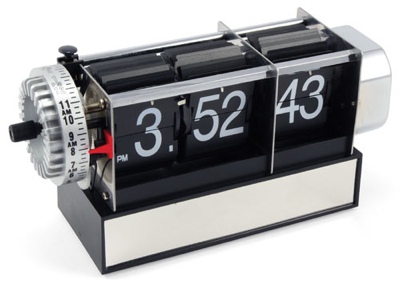
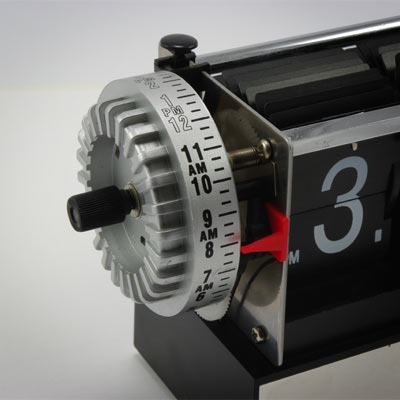
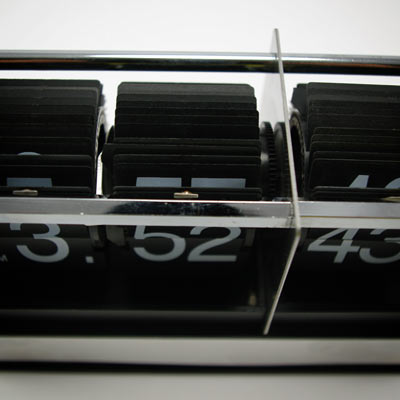
Flip Clocks from Wikipedia:
An electric motor turns two wheels continuously: the faster at a rate of 1 revolution per hour, the slower at a rate of 1 revolution per 24 hours. The wheels move continuously, not in steps.
The faster wheel has connected to it a ring of 60 flat plastic “leaves”. On the “leaves” are printed numerals so that, when you hold two adjacent “leaves” apart like an open book, the two open “leaves” spell out a numeral, and flipping a “leaf” increases the number shown by 1 unit. The “book” is opened vertically, and its pages form a ring. This ring is put into position and rotated so that one page falls each minute, showing a new number for the minutes. “Leaves” 45 through 59 have a small tooth on them. The purpose of this tooth is explained later.
The slower wheel has connected to it a similar ring of “leaves”, but there are only 48 “leaves” on this ring. These “leaves” have hour numbers printed on them. There are two of each hour, like this: 12am, 12am, 1am, 1am, 2am, 2am, … 11pm, 11pm. One leaf falls each half-hour, at approximately 25 and 55 minutes after the hour. A different design features 60 “leaves” with the numbers 1 to 12 repeated in fives, each leaf falling after 12 minutes. The disadvantage of this is that there is no way to show “AM” or “PM” information.
The teeth on the minute leaves are used as follows: at 45 minutes after the hour, the tooth pushes a lever which will catch any falling hour leaf. The lever holds the old hour leaf in place until it is time for the new hour to start.
FTA:
Some measure time with a pendulum. Others measure it with springs. Still others rely on crystals. We monkeys prefer monitoring the subtle oscillations of cesium atoms in a vacuum. Pick your own way - make it yours. See, Time is a constant companion and should be feared and respected.
Even Gollum knew all about Time. It can slay kings, ruin towns and beat high mountains down. Time can let you know when you need to catch the train, or when the latest episode of The Guild is online. Still, time is an abstract concept. Most animals don’t understand why their instincts tell them to start swimming upstream to spawn, but we higher-apes need our day violently split into 86,400 seconds just so we can get things done. We turned time into an absolute - something to be measured, labeled and tamed.
This clock is unique in that its mechanism is exposed for all to see. Notice how the plates rotate against a bent metal finger that releases them only when it is the next plate’s turn to fall. Watch the curious dance - the harmony of motors and gears. See, originally this clock had a case covering it, but through a happy accident, it was forgotten. It looks even cooler the way it is, so there you have it.
Details
- Battery powered alarm “flip” style clock
- 24 hour alarm
- Remarkably precise, though seconds are for display purposes only
- Requires 2 “C” cell batteries (not included)
- 17.5cm x 6cm x 9cm
Buy it now from ThinkGeek.com
- Details
By ThinGeek (OEM Unknown)
Price $35
This is another gimmick clock but it is well executed and it looks nice. Each HH MM SS display is separated in to its own cube with the controls on the HH. They are tethered with a small wire and the whole device is powered via a mains transformer. For $35, you can't go wrong with one of these.
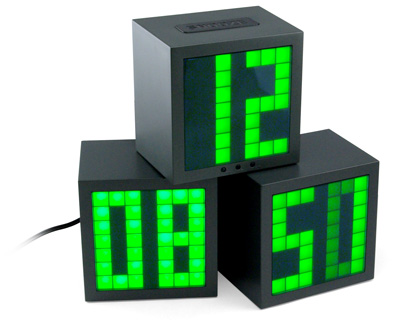
FTA
A customer sent us an email once and she said, ‘ThinkGeek? Why can’t you make us an alarm clock that has a techie feel but is also stylish?’ We pondered the question, drafted some blueprints, built a prototype from pop tarts and LED arrays, and, voila - the Matrix Cube Clock was born. Ask, and you shall receive. Connected by thin ribbon cables, each clock module can be stacked vertically, horizontally or in a pyramid, depending on your mood and the alignment of Jupiter and Saturn’s moons.
Dimensions: Each cube is approximately 3.5″ square. 12 or 24 hour format available! Even includes a snooze button. Woohoo!
Buy it now at ThinkGeek.com
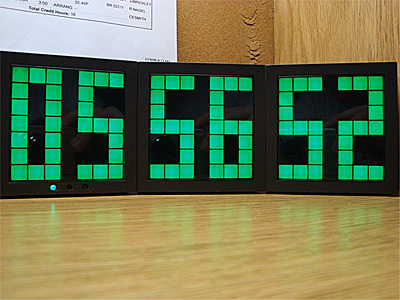
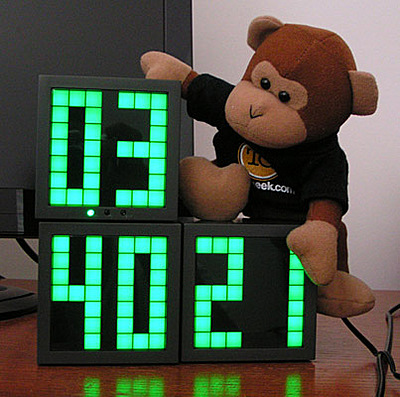
- Details
By HP / Agilent - discontinued

Does anyone want a cesium beam frequency standard? OF COURSE YOU DO! That's why you're reading this site. You like things like that. Well, I have the thing for you: The 5071A Primary Frequency Standard.
You can actually find these on eBay for $2k to $10k. However, in most all cases, you will need to buy a new cesium source for the clock. I have no idea how much that part costs but I would imagine shipping radioactive material will command a premium on top of the normal UPS / FedEx charges. I think if I ever got a package like that at work it would make people suspicious. (But they already know I’m weird.)
Specifications
- Performance suited to advanced communications and tracking systems
- Frequency accuracy to 5 x 10-13
- Long-term stability better than 1 x 10-14
- Proven track record in military and commercial applications
- Easy to use with automatic start up and intuitive menu structure
Key Points
- Performance suited to advanced communications and tracking systems
- Frequency accuracy to 5 x 10-13
- Long-term stability better than 1 x 10-14
- Proven track record in military and commercial applications
- Easy to use with automatic start up and intuitive menu structure

